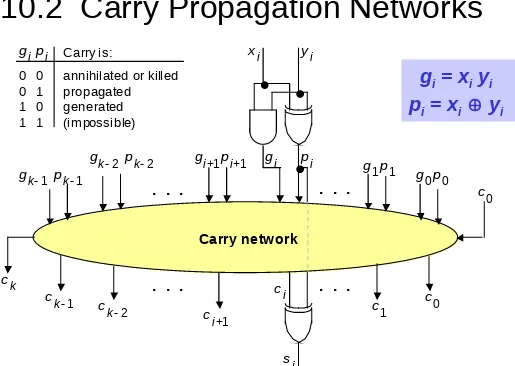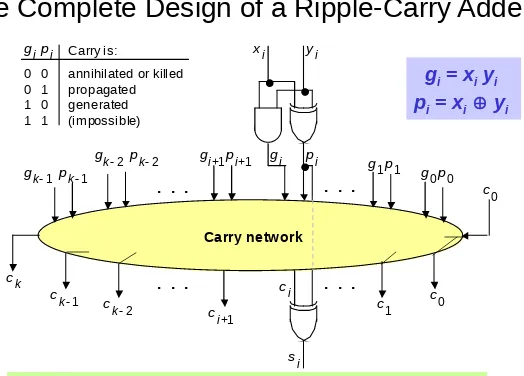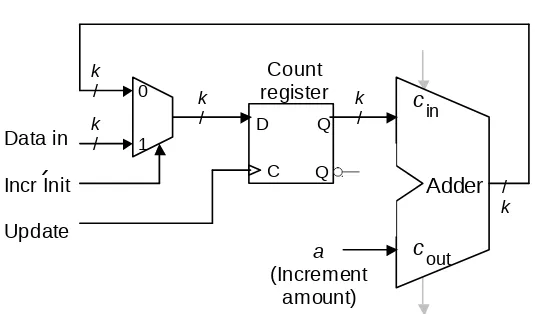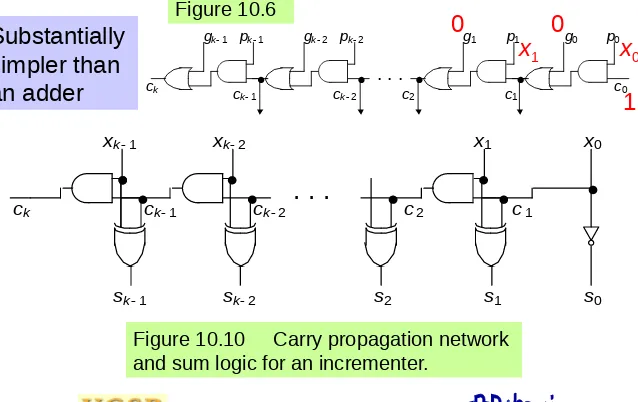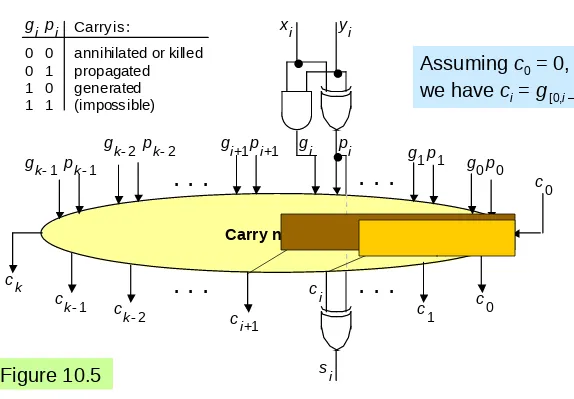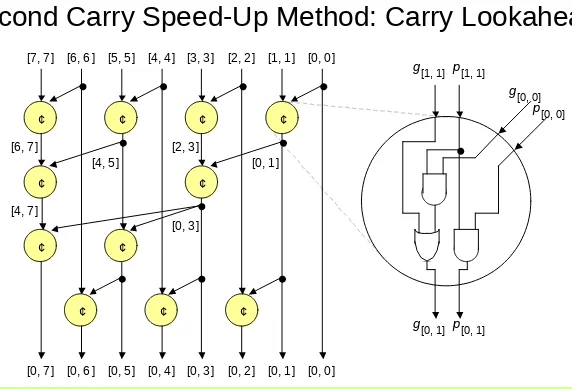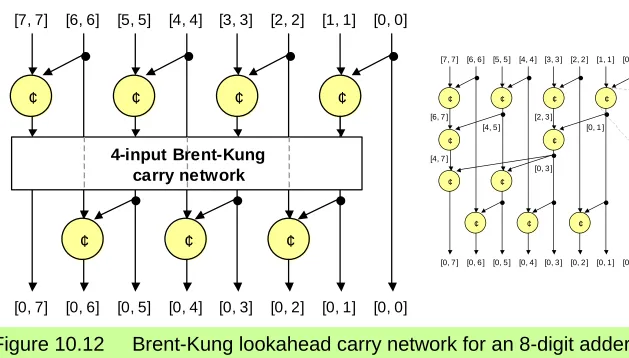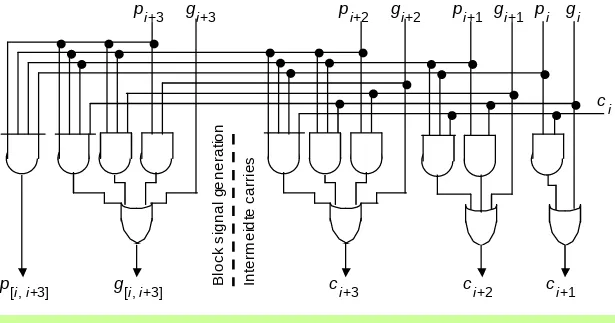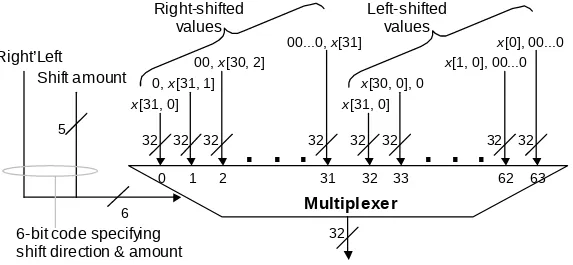Jan. 2011
Computer Architecture, The
Arithmetic/Logic Unit
Slide 1
Part III
Jan. 2011
Computer Architecture, The
Arithmetic/Logic Unit
Slide 2
About This Presentation
This presentation is intended to support the use of the textbook
ComputerArchitecture:FromMicroprocessorstoSupercomputers, Oxford University Press, 2005, ISBN 0-19-515455-X. It is updated regularly by the author as part of his teaching of the
upper-division course ECE 154, Introduction to Computer Architecture, at the University of California, Santa Barbara. Instructors can use these slides freely in classroom teaching and for other
educational purposes. Any other use is strictly prohibited. © BehroozParhami
Edition Released Revised Revised Revised Revised
First July 2003 July 2004 July 2005 Mar. 2006 Jan. 2007
Jan. 2011
Computer Architecture, The
Arithmetic/Logic Unit
Slide 3
III The Arithmetic/Logic Unit
Topics in This Part
Chapter 9 Number Representation
Chapter 10 Adders and Simple ALUs
Chapter 11 Multipliers and Dividers
Chapter 12 Floating-Point Arithmetic
Overview of computer arithmetic and ALU design:
Jan. 2011
Computer Architecture, The
Arithmetic/Logic Unit
Slide 4
Preview of Arithmetic Unit in the Data Path
Fig. 13.3 Key elements of the single-cycle MicroMIPS data path.
/
ALU cache Data
Instr cache Next addr Reg file op jta fn inst imm
rs (rs)
(rt) Data addr Data in 0 1 ALUSrc
ALUFunc DataWrite DataRead SE RegInSrc rt rd RegDst RegWrite 32 / 16 Register input Data out Func ALUOvfl Ovfl 31 0 1 2 Next PC Incr PC (PC) Br&Jump ALU out PC 0 1 2
Instruction fetch Reg access / decode ALU operation Data access
Jan. 2011
Computer Architecture, The
Arithmetic/Logic Unit
Slide 5
Computer Arithmetic as a Topic of Study
Brief overview article –
Encyclopedia of Info Systems, Academic Press, 2002,
Vol. 3, pp. 317-333
Our textbook’s treatment of the topic falls between the extremes (4 chaps.)
Graduate course ECE 252B – Text:
Jan. 2011
Computer Architecture, The
Arithmetic/Logic Unit
Slide 6
9 Number Representation
Arguably the most important topic in computer arithmetic:
• Affects system compatibility and ease of arithmetic
• Two’s complement, flp, and unconventional methods
Topics in This Chapter
9.1 Positional Number Systems 9.2 Digit Sets and Encodings 9.3 Number-Radix Conversion 9.4 Signed Integers
Jan. 2011
Computer Architecture, The
Arithmetic/Logic Unit
Slide 7
9.1 Positional Number Systems
Representations of natural numbers {0, 1, 2, 3, …}
||||| ||||| ||||| ||||| ||||| || sticks or unary code
27 radix-10 or decimal code
11011 radix-2 or binary code
XXVII Roman numerals
Fixed-radix positional representation with
k
digits
Value of a number: x = (xk–1xk–2 . . . x1x0)r =
xi r i For example:27 = (11011)two = (124) + (123) + (022) + (121) + (120)
Number of digits for [0, P]: k = logr (P + 1) = logr P + 1
k–1
Jan. 2011
Computer Architecture, The
Arithmetic/Logic Unit
Slide 8
Unsigned Binary Integers
Figure 9.1 Schematic representation of 4-bit code for integers in [0, 15].
0000 0001 1111 0010 1110 0011 1101 0100 1100 1000 0101 1011 0110 1010 0111 1001 0 1 2 3 4 5 6 7 15 11 14 13 12 8 9 10
Inside: Natural number Outside: 4-bit encoding
0 1 2 3 15 4 5 6 7 8 9
Turn x notches counterclockwise
to add x
Turn y notches clockwise to subtract y
11 14 13 12
Jan. 2011
Computer Architecture, The
Arithmetic/Logic Unit
Slide 9
Representation Range and Overflow
Figure 9.2 Overflow regions in finite number representation systems. For unsigned representations covered in this section, max – = 0.
max
Finite set of representable numbers
Overflow region
max
Overflow region
Numbers larger than max
Numbers smaller than max
Example 9.2, Part d
Discuss if overflow will occur when computing 317 – 316 in a number system with k = 8 digits in radix r = 10.
Solution
Jan. 2011
Computer Architecture, The
Arithmetic/Logic Unit
Slide 10
9.2 Digit Sets and Encodings
Conventional and unconventional digit sets
Decimal digits in [0, 9]; 4-bit BCD, 8-bit ASCII
Hexadecimal, or hex for short: digits 0-9 & a-f
Conventional ternary digit set in [0, 2]
Conventional digit set for radix
r
is [0,
r
– 1]
Symmetric ternary digit set in [–1, 1]
Conventional binary digit set in [0, 1]
Redundant digit set [0, 2], encoded in 2 bits
( 0 2 1 1 0 )
Jan. 2011
Computer Architecture, The
Arithmetic/Logic Unit
Slide 11
Carry-Save Numbers
Radix-2 numbers using the digits 0, 1, and 2
Example: (1 0 2 1)two = (123) + (022) + (221) + (120) = 13 Possible encodings
(a) Binary (b) Unary
0 00 0 00
1 01 1 01 (First alternate)
2 10 1 10 (Second alternate)
11 (Unused) 2 11
1 0 2 1 1 0 2 1
Jan. 2011
Computer Architecture, The
Arithmetic/Logic Unit
Slide 12
Figure 9.3 Adding a binary number or another
carry-save number to a carry-save number.
The Notion of Carry-Save Addition
Two carry-save
inputs Carry-save
input
Binary input
Carry-save output
This bit being 1 represents
overflow (ignore it)
0 0
0
a. Carry-save addition. b. Adding two carry-save numbers.
Carry-save addition
Carry-save addition
Jan. 2011
Computer Architecture, The
Arithmetic/Logic Unit
Slide 13
9.3 Number Radix Conversion
Perform arithmetic in the new radix
R
Suitable for conversion from radix r to radix 10
Horner’s rule:
(xk–1xk–2 . . . x1x0)r = (…((0 + xk–1)r + xk–2)r + . . . + x1)r + x0
(1 0 1 1 0 1 0 1)two = 0 + 1 1 2 + 0 2 2 + 1 5 2 + 1
11 2 + 0 22 2 + 1 45 2 + 0 90 2 + 1 181
Perform arithmetic in the old radix
r
Suitable for conversion from radix 10 to radix R
Divide the number by R, use the remainder as the LSD and the quotient to repeat the process
19 / 3 rem 1, quo 6 / 3 rem 0, quo 2 / 3 rem 2, quo 0
Thus, 19 = (2 0 1)three
Jan. 2011
Computer Architecture, The
Arithmetic/Logic Unit
Slide 14
Justifications for Radix Conversion Rules
Figure 9.4 Justifying one step of the conversion of x to radix 2.
x 0
x mod 2 Binary representation of x/2
Justifying Horner’s rule.
1 2
1 2 0 1 2 1 0
(
x x
k kx
)
rx r
k kx r
k kx r x
L
L
0
(
1(
2( )))
x
r x
r x
r
Jan. 2011
Computer Architecture, The
Arithmetic/Logic Unit
Slide 15
9.4 Signed Integers
We dealt with representing the natural numbers
Signed or directed whole numbers = integers
{ . . . , 3, 2, 1, 0, 1, 2, 3, . . . }
Signed-magnitude representation
+27 in 8-bit signed-magnitude binary code 0 0011011 –27 in 8-bit signed-magnitude binary code 1 0011011 –27 in 2-digit decimal code with BCD digits 1 0010 0111
Biased representation
Represent the interval of numbers [N, P] by the unsigned
Jan. 2011
Computer Architecture, The
Arithmetic/Logic Unit
Slide 16
Two’s-Complement Representation
Figure 9.5 Schematic representation of 4-bit 2’s-complement code for integers in [–8, +7].
0000 0001 1111 0010 1110 0011 1101 0100 1100 1000 0101 1011 0110 1010 0111 1001 +0 +1 +2 +3 +4 +5 +6 +7 �1 �5 �2 �3 �4 �8 �7 �6
+
_
01 2 3 �1 4 5 6 7 �8 �7
Turn x notches counterclockwise
to add x
Turn 16 �y notches counterclockwise to
add �y (subtract y) �5
�2
�3
�4
�6
Jan. 2011
Computer Architecture, The
Arithmetic/Logic Unit
Slide 17
Conversion from 2’s-Complement to Decimal
Example 9.7Convert x = (1 0 1 1 0 1 0 1)2’s-compl to decimal.
Solution
Given that x is negative, one could change its sign and evaluate –x. Shortcut: Use Horner’s rule, but take the MSB as negative
–1 2 + 0 –2 2 + 1 –3 2 + 1 –5 2 + 0 –10 2 +
1 –19 2 + 0 –38 2 + 1 –75
Example 9.8
Sign Change for a 2’s-Complement Number
Given y = (1 0 1 1 0 1 0 1)2’s-compl, find the representation of –y.
Solution
Jan. 2011
Computer Architecture, The
Arithmetic/Logic Unit
Slide 18
Two’s-Complement Addition and Subtraction
Figure 9.6 Binary adder used as 2’s-complement adder/subtractor.
Add
Sub
x
y
y
x
k
/
k
/
k
/
y
or
y
Adder
c
outc
ink
Jan. 2011
Computer Architecture, The
Arithmetic/Logic Unit
Slide 19
9.5 Fixed-Point Numbers
Positional representation:
k
whole and
l
fractional digits
Value of a number: x = (xk–1xk–2. . .x1x0.x–1x–2 . . . x–l )r =
xi r i For example:2.375 = (10.011)two = (121) + (020) + (021) + (122) + (123) Numbers in the range [0, rk – ulp] representable, where ulp = r–l
Fixed-point arithmetic same as integer arithmetic (radix point implied, not explicit)
Jan. 2011
Computer Architecture, The
Arithmetic/Logic Unit
Slide 20
Fixed-Point 2’s-Complement Numbers
Figure 9.7 Schematic representation of 4-bit 2’s-complement encoding for (1 + 3)-bit fixed-point numbers in the range [–1, +7/8].
0.000
0.001 1.111
0.010 1.110
0.011 1.101
0.100 1.100
1.000
0.101 1.011
0.110 1.010
0.111 1.001
+0
+.125
+.25
+.375
+.5
+.625
+.75
+.875
�.125
�.625
�.25
�.375
�.5
�1
�.875
�.75
Jan. 2011
Computer Architecture, The
Arithmetic/Logic Unit
Slide 21
Radix Conversion for Fixed-Point Numbers
Perform arithmetic in the new radix
R
Evaluate a polynomial in r–1: (.011)
two = 0 2–1 + 1 2–2 + 1 2–3
Simpler: View the fractional part as integer, convert, divide by rl
(.011)two = (?)ten
Multiply by 8 to make the number an integer: (011)two = (3)ten
Thus, (.011)two = (3 / 8)ten = (.375)ten
Perform arithmetic in the old radix
r
Multiply the given fraction by R, use the whole part as the MSD and the fractional part to repeat the process
(.72)ten = (?)two
0.72 2 = 1.44, so the answer begins with 0.1
0.44 2 = 0.88, so the answer begins with 0.10
Convert the whole and fractional parts separately.
Jan. 2011
Computer Architecture, The
Arithmetic/Logic Unit
Slide 22
9.6 Floating-Point Numbers
Fixed-point representation must sacrifice precision
for small values to represent large values
x
= (0000 0000
.
0000 1001)
twoSmall number
y
= (1001 0000
.
0000 0000)
twoLarge number
Neither
y
2nor
y
/
x
is representable in the format above
Floating-point representation is like scientific notation:
20 000 000 =
2
107 +0.000 000 007 = +7
10–9Useful for applications where very large and very small
numbers are needed simultaneously
Also, 7E9
Significand Exponent base Exponent
Jan. 2011
Computer Architecture, The
Arithmetic/Logic Unit
Slide 23
ANSI/IEEE Standard Floating-Point Format (IEEE 754)
Figure 9.8 The two ANSI/IEEE standard floating-point formats.
Short (32-bit) format
Long (64-bit) format
Sign Exponent Significand
8 bits, bias = 127,
�126 to 127
11 bits,
bias = 1023,
�1022 to 1023 52 bits for fractional part (plus hidden 1 in integer part) 23 bits for fractional part
(plus hidden 1 in integer part)
Short exponent range is –127 to 128 but the two extreme values are reserved for special operands
(similarly for the long format)
Jan. 2011
Computer Architecture, The
Arithmetic/Logic Unit
Slide 24
Short and Long IEEE 754 Formats: Features
Table 9.1 Some features of ANSI/IEEE standard floating-point formats
Feature Single/Short Double/Long
Word width in bits 32 64
Significand in bits 23 + 1 hidden 52 + 1 hidden Significand range [1, 2 – 2–23] [1, 2 – 2–52]
Exponent bits 8 11
Exponent bias 127 1023
Zero (±0) e + bias = 0, f = 0 e + bias = 0, f = 0 Denormal e + bias = 0, f ≠ 0
represents ±0.f 2–126 erepresents ±0. + bias = 0, f ≠ 0f 2–1022
Infinity (∞) e + bias = 255, f = 0 e + bias = 2047, f = 0
Not-a-number (NaN) e + bias = 255, f ≠ 0 e + bias = 2047, f ≠ 0 Ordinary number e + bias [1, 254]
e [–126, 127]
represents 1.f 2e
e + bias [1, 2046]
e [–1022, 1023]
represents 1.f 2e
Jan. 2011
Computer Architecture, The
Arithmetic/Logic Unit
Slide 25
10 Adders and Simple ALUs
Addition is the most important arith operation in computers:
• Even the simplest computers must have an adder
• An adder, plus a little extra logic, forms a simple ALU
Topics in This Chapter
10.1 Simple Adders
10.2 Carry Propagation Networks 10.3 Counting and Incrementation 10.4 Design of Fast Adders
Jan. 2011
Computer Architecture, The
Arithmetic/Logic Unit
Slide 26
10.1 Simple Adders
Figures 10.1/10.2 Binary half-adder (HA) and full-adder (FA).
x y c s
0 0 0 0 0 1 0 1 1 0 0 1 1 1 1 0
Inputs Outputs
HA
x y
c
s
x y c c s
0 0 0 0 0 0 0 1 0 1 0 1 0 0 1 0 1 1 1 0 1 0 0 0 1 1 0 1 1 0 1 1 0 1 0 1 1 1 1 1
Inputs Outputs
c out c in
out
in x y
s
FA
Digit-set interpretation: {0, 1} + {0, 1}
= {0, 2} + {0, 1}
Jan. 2011
Computer Architecture, The
Arithmetic/Logic Unit
Slide 27
Full-Adder Implementations
Figure10.3 Full adder implemented with two half-adders, by means of two 4-input multiplexers, and as two-level gate network.
(a) FA built of two HAs
(c) Two-level AND-OR FA (b) CMOS mux-based FA
1
0
3
2
HA
HA
1
0
3
2
0
1
x y
x y
x y
s
s s
c out
c out c out
c in
Jan. 2011
Computer Architecture, The
Arithmetic/Logic Unit
Slide 28
Ripple-Carry Adder: Slow But Simple
Figure 10.4 Ripple-carry binary adder with 32-bit inputs and output. x
s y
c c
x
s y
c
x
s y
c
c out c in
0 0
0
c 0
1 1
1
1 2
31
31
31 31
FA FA FA
32
. . .
Jan. 2011
Computer Architecture, The
Arithmetic/Logic Unit
Slide 29
Carry Chains and Auxiliary Signals
Bit positions
15 14 13 12 11 10 9 8 7 6 5 4 3 2 1 0 1 0 1 1 0 1 1 0 0 1 1 0 1 1 1 0
cout 0 1 0 1 1 0 0 1 1 1 0 0 0 0 1 1 cin
\__________/\__________________/ \________/\____/ 4 6 3 2
Carry chains and their lengths
Jan. 2011
Computer Architecture, The
Arithmetic/Logic Unit
Slide 30
[image:30.720.118.633.46.412.2]10.2 Carry Propagation Networks
Figure 10.5 The main part of an adder is the carry network. The rest is just a set of gates to produce the g and p signals and the sum bits.
Carry network
. . .
. . .
x i y i
g p
s i i
i c i
c i+1 c k1
c k
c k2 c 1
c 0 g p 1 1
g p 0 0 g k2 p k2 g p i+1 i+1
g k1 p k1
c 0
. . .
. . .
0 0 0 1 1 0 1 1
annihilated or killed propagated
generated (impossible) Carry is: g i p i
Jan. 2011
Computer Architecture, The
Arithmetic/Logic Unit
Slide 31
Ripple-Carry Adder Revisited
Figure 10.6 The carry propagation network of a ripple-carry adder.
. . .
c k1
c k c
k2 c 1
g 1 p 1 g 0 p 0 g k2 p k2
g k1 p k1
c 0 c 2
The carry recurrence:
c
i+1= g
i
p
ic
iLatency of k-bit adder is roughly 2k gate delays:
1 gate delay for production of p and g signals, plus 2(k – 1) gate delays for carry propagation, plus
Jan. 2011
Computer Architecture, The
Arithmetic/Logic Unit
Slide 32
[image:32.720.113.637.48.424.2]The Complete Design of a Ripple-Carry Adder
Figure 10.6 (ripple-carry network) superimposed on Figure 10.5 (general structure of an adder).
Carry network
. . .
. . .
x i y i
g p
s i i
i c i
c i+1 c k1
c k
c k2 c 1
c 0 g p 1 1
g p 0 0 g k2 p k2 g p i+1 i+1
g k1 p k1
c 0
. . .
. . .
0 0 0 1 1 0 1 1
annihilated or killed propagated
generated (impossible) Carry is: g i p i
Jan. 2011
Computer Architecture, The
Arithmetic/Logic Unit
Slide 33
First Carry Speed-Up Method: Carry Skip
Figures 10.7/10.8 A 4-bit section of a ripple-carry network with skip paths and the driving analogy.
c
g 4j+1 p 4j+1 g 4j p 4j
g 4j+2 p 4j+2
g 4j+3 p 4j+3
c 4j
4j+4 c 4j+3 c 4j+2 c 4j+1
One-way street
Jan. 2011
Computer Architecture, The
Arithmetic/Logic Unit
Slide 34
Mux-Based Skip Carry Logic
The carry-skip adder of Fig. 10.7 works fine if we begin with a clean slate, where all signals are 0s; otherwise, it will run into problems, which do not exist in this mux-based implementation
c
g 4j+1 p 4j+1 g 4j p 4j g 4j+2 p 4j+2
g 4j+3 p 4j+3
c 4j
4j+4 c 4j+3 c 4j+2 c 4j+1
0 1
p[4j, 4j+3] c4j+4
c
g 4j+1 p 4j+1 g 4j p 4j
g 4j+2 p 4j+2
g 4j+3 p 4j+3
c 4j
[image:34.720.52.673.28.436.2]4j+4 c 4j+3 c 4j+2 c 4j+1
Jan. 2011
Computer Architecture, The
Arithmetic/Logic Unit
Slide 35
[image:35.720.91.626.103.417.2]10.3 Counting and Incrementation
Figure 10.9 Schematic diagram of an initializable synchronous counter.
D Q
C
_
Q D
c
outc
inAdder
Update
/
k k
/
a
(Increment amount) Count
register k
/ 1
0
Data in
k
/
k
/
Jan. 2011
Computer Architecture, The
Arithmetic/Logic Unit
Slide 36
Circuit for Incrementation by 1
[image:36.720.48.686.98.500.2]Substantially
simpler than
an adder
Figure 10.10 Carry propagation network and sum logic for an incrementer.
1 0
k2 k1
. . .
c k1
c k c k2 c 1
x x
x x
c 2
1 0
k2
k1 s s s
s s 2
. . .
c k1
c k c
k2 c 1
g 1 p 1 g 0 p 0
g k2 p k2
g k1 p k1
c 0
c 2
0
0
x
0x
1Figure 10.6
Jan. 2011
Computer Architecture, The
Arithmetic/Logic Unit
Slide 37
Carries can be computed directly without propagation
For example, by unrolling the equation for
c
3, we get:
c3 = g2 p2 c2 = g2 p2 g1 p2 p1 g0 p2 p1 p0 c0
We define “generate” and “propagate” signals for a block
extending from bit position
a
to bit position
b
as follows:
g[a,b] = gb pb gb–1 pb pb–1gb–2 . . . pb pb–1…pa+1 ga
p[a,b] = pb pb–1. . . pa+1 pa
Combining
g
and
p
signals for adjacent blocks:
g[h,j] = g[i+1,j] p[i+1,j] g[h,i]
p[h,j] = p[i+1,j] p[h,i]
10.4 Design of Fast Adders
h i
i+1
j
Jan. 2011
Computer Architecture, The
Arithmetic/Logic Unit
Slide 38
[image:38.720.73.647.74.473.2]Carries as Generate Signals for Blocks [
0,
i
]
Figure 10.5
Carry network
. . .
. . .
x i y i
g p
s
i i
i
c i c i+1
c k1 c k
c k2 c 1
c 0 g p 1 1
g p 0 0 g k2 p k2 g p i+1 i+1
g k1 p k1
c 0
. . .
. . .
0 0 0 1 1 0 1 1
annihilated or killed propagated
generated (impossible) Carry is:
g i p i
Jan. 2011
Computer Architecture, The
Arithmetic/Logic Unit
Slide 39
[image:39.720.75.647.39.428.2]Second Carry Speed-Up Method: Carry Lookahead
Figure 10.11 Brent-Kung lookahead carry network for an 8-digit adder, along with details of one of the carry operator blocks.
¢ ¢ ¢ ¢
¢ ¢
¢ ¢
¢ ¢ ¢
[7, 7 ] [6, 6 ] [5, 5 ] [4, 4 ] [3, 3] [2, 2 ] [1, 1 ] [0, 0]
[0, 7 ] [0, 6 ] [0, 5 ] [0, 4 ] [0, 3] [0, 2 ] [0, 1 ] [0, 0] [2, 3]
[4, 5 ] [6, 7 ]
[4, 7 ]
[0, 3]
[0, 1 ]
g [0, 0]
g [0, 1] g [1, 1]
p [0, 0]
Jan. 2011
Computer Architecture, The
Arithmetic/Logic Unit
Slide 40
[image:40.720.45.674.87.445.2]Recursive Structure of Brent-Kung Carry Network
Figure 10.12 Brent-Kung lookahead carry network for an 8-digit adder, with only its top and bottom rows of carry-operators shown.
¢ ¢ ¢ ¢
¢ ¢ ¢
[7, 7] [6, 6] [5, 5] [4, 4] [3, 3] [2, 2] [1, 1] [0, 0]
[0, 7] [0, 6] [0, 5] [0, 4] [0, 3] [0, 2] [0, 1] [0, 0]
4-input Brent-Kung carry network
¢ ¢ ¢ ¢
¢ ¢
¢ ¢
¢ ¢ ¢
[7, 7] [6, 6 ] [5, 5] [4, 4] [3, 3] [2, 2 ] [1, 1] [0, 0 ]
[0, 7] [0, 6 ] [0, 5] [0, 4] [0, 3] [0, 2 ] [0, 1] [0, 0 ] [2, 3 ]
[4, 5] [6, 7 ]
[4, 7 ]
[0, 3 ]
[0, 1 ]
g [0, 0]
g [0, 1] g [1, 1]
p [0, 0]
Jan. 2011
Computer Architecture, The
Arithmetic/Logic Unit
Slide 41
An Alternate Design: Kogge-Stone Network
Kogge-Stone lookahead carry network for an 8-digit adder.
¢ ¢ ¢ ¢
¢ ¢ ¢ ¢
¢ ¢
¢ ¢ ¢ ¢
¢
¢ ¢
c1 = g[0,0]
c2 = g[0,1]
c3 = g[0,2]
c8 = g[0,7] c4 = g[0,3]
c5 = g[0,4]
c6 = g[0,5]
Jan. 2011
Computer Architecture, The
Arithmetic/Logic Unit
Slide 42
¢ ¢ ¢ ¢
¢ ¢
¢ ¢
¢ ¢ ¢
[7, 7 ] [6, 6 ] [5, 5 ] [4, 4 ] [3, 3 ] [2, 2 ] [1, 1 ] [0, 0 ]
[0, 7 ] [0, 6 ] [0, 5 ] [0, 4 ] [0, 3 ] [0, 2 ] [0, 1 ] [0, 0 ] [2, 3 ]
[4, 5 ] [6, 7]
[4, 7]
[0, 3 ]
[0, 1 ]
g [0, 0]
g [0, 1] g [1, 1]
p [0, 0]
p [0, 1] p [1, 1]
Brent-Kung vs. Kogge-Stone Carry Network
11 carry operators 4 levels
Jan. 2011
Computer Architecture, The
Arithmetic/Logic Unit
Slide 43
[image:43.720.49.664.105.428.2]Carry-Lookahead Logic with 4-Bit Block
Figure 10.13 Blocks needed in the design of carry-lookahead adders with four-way grouping of bits.
B
lo
ck
s
ig
n
a
l g
e
n
e
ra
tio
n
p [i, i+3]
c i
In
te
rm
e
id
te
c
a
rr
ie
s
c i+1 c i+2
c i+3 g [i, i+3]
Jan. 2011
Computer Architecture, The
Arithmetic/Logic Unit
Slide 44
Third Carry Speed-Up Method: Carry Select
Figure 10.14 Carry-select addition principle.
c out c in
Adder
Version 1 of sum bits
1 0
x
[a, b]
c out c in
Adder
Version 0 of sum bits
y
[a, b]
s
[a, b]
c
a
0 1
Allows doubling of adder width with a single-mux additional delay
The lower
a positions, (0 to a – 1)
Jan. 2011
Computer Architecture, The
Arithmetic/Logic Unit
Slide 45
10.5 Logic and Shift Operations
[image:45.720.72.645.152.417.2]Conceptually, shifts can be implemented by multiplexing
Figure 10.15 Multiplexer-based logical shifting unit.
Multiplexer
0 1 2 31 32 33 62 63
5
6
Right’Left
Shift amount 0, x[31, 1]
x[31, 0]
00, x[30, 2]
00...0, x[31]
x[31, 0]
x[30, 0], 0
x[1, 0], 00...0
x[0], 00...0
. . .
. . .
32
32 32 32 32 32 32 32 32
6-bit code specifying shift direction & amount
Right-shifted values
Jan. 2011
Computer Architecture, The
Arithmetic/Logic Unit
Slide 46
[image:46.720.52.656.140.437.2]Arithmetic Shifts
Figure 10.16 The two arithmetic shift instructions of MiniMIPS.
Purpose: Multiplication and division by powers of 2
sra $t0,$s1,2 # $t0 ($s1) right-shifted by 2
srav $t0,$s1,$s0 # $t0 ($s1) right-shifted by ($s0)
1 1
1 1
0 0 0
fn
0 0 0 0 0 0 0 0 0 0 0 1 0 0
0 0 0 0 0 0 1 0 0 0 1 1 0
31 25 20 15 0
ALU
instruction Unused register Source
op rs rt
R
rd sh
10 5
Destination
register amount Shift sra = 3
1
0 0 0 0 0 0 0 0 0 0 0 0 0 0 0
0 0 1 0 0 0 0 1 0 0 0 1 1 0
31 25 20 15 0
ALU instruction
Amount register
Source register
op rs rt
R
rd sh
10 5 fn
Destination register
Jan. 2011
Computer Architecture, The
Arithmetic/Logic Unit
Slide 47
Practical Shifting in Multiple Stages
Figure 10.17 Multistage shifting in a barrel shifter.
2
0, x[31, 1]
x[31, 0]
x[30, 0], 0
32
0 1 2 3
32 32 32 32
0 0 No shift 0 1 Logical left 1 0 Logical right
1 1 Arith right x[31], x[31, 1]
Multiplexer
2
0 1 2 3
(0 or 4)-bit shift
2
0 1 2 3
(0 or 2)-bit shift
2
0 1 2 3
(0 or 1)-bit shift
(a) Single-bit shifter (b) Shifting by up to 7 bits
y[31, 0]
Jan. 2011
Computer Architecture, The
Arithmetic/Logic Unit
Slide 48
Figure 10.18 A 4
8 block of a black-and-white
image represented as a 32-bit word.
Bit Manipulation via Shifts and Logical Operations
AND with mask to isolate a field: 0000 0000 0000 0000 1111 1100 0000 0000
Right-shift by 10 positions to move field to the right end of word
The result word ranges from 0 to 63, depending on the field pattern
32-pixel (4 8) block of
black-and-white image:
1010 0000 0101 1000 0000 0110 0001 0111
Representation as 32-bit word:
Hex equivalent: 0xa0a80617
Row 0 Row 1 Row 2 Row 3
Jan. 2011
Computer Architecture, The
Arithmetic/Logic Unit
Slide 49
10.6 Multifunction ALUs
General structure of a simple arithmetic/logic unit.
Logic unit Arith
unit 0
1
Operand 1
Operand 2
Result
Logic fn (AND, OR, . . .) Arith fn (add, sub, . . .)
Jan. 2011
Computer Architecture, The
Arithmetic/Logic Unit
Slide 50
An ALU for
MiniMIPS
Figure 10.19 A multifunction ALU with 8 control signals (2 for
function class, 1 arithmetic, 3 shift, 2 logic) specifying the operation.
AddSub
x y
y x
Adder
c 32 c 0
k / Shifter Logic unit s Logic function Amount 5 2 Constant amount Variable amount 5 5
ConstVar
0 1 0 1 2 3 Function class 2 Shift function
5 LSBs Shifted y 32
32
32
2
c 31
32-input NOR Ovfl Zero 32 32 MSB ALU y x s Shorthand symbol for ALU Ovfl Zero Func Control 0 or 1
AND 00 OR 01 XOR 10 NOR 11
00 Shift 01 Set less 10 Arithmetic 11 Logic 00 No shift
Jan. 2011
Computer Architecture, The
Arithmetic/Logic Unit
Slide 51
11 Multipliers and Dividers
Modern processors perform many multiplications & divisions:
• Encryption, image compression, graphic rendering
• Hardware vs programmed shift-add/sub algorithms
Topics in This Chapter
11.1 Shift-Add Multiplication 11.2 Hardware Multipliers
11.3 Programmed Multiplication 11.4 Shift-Subtract Division
Jan. 2011
Computer Architecture, The
Arithmetic/Logic Unit
Slide 52
11.1 Shift-Add Multiplication
Figure 11.1 Multiplication of 4-bit numbers in dot notation.
Multiplicand
Partial products bit-matrix
x y
z
y x 2 0 0
y x 2 1 1
y x 2 2 2
y x 2 3 3
Multiplier
Product
z
(j+1)= (
z
(j)+
y
j
x
2
k) 2
–1with
z
(0)= 0 and
z
(k)=
z
|––– add –––|
Jan. 2011
Computer Architecture, The
Arithmetic/Logic Unit
Slide 53
Binary and Decimal Multiplication
Figure 11.2 Step-by-step multiplication examples for 4-digit unsigned numbers.
Position 7 6 5 4 3 2 1 0 Position 7 6 5 4 3 2 1 0
========================= =========================
x24 1 0 1 0 x104 3 5 2 8
y 0 0 1 1 y 4 0 6 7
========================= =========================
z(0) 0 0 0 0 z(0) 0 0 0 0
+y0x24 1 0 1 0 +y
0x104 2 4 6 9 6
–––––––––––––––––––––––––– ––––––––––––––––––––––––––
2z(1) 0 1 0 1 0 10z(1) 2 4 6 9 6
z(1) 0 1 0 1 0 z(1) 0 2 4 6 9 6
+y1x24 1 0 1 0 +y
1x104 2 1 1 6 8
–––––––––––––––––––––––––– ––––––––––––––––––––––––––
2z(2) 0 1 1 1 1 0 10z(2) 2 3 6 3 7 6
z(2) 0 1 1 1 1 0 z(2) 2 3 6 3 7 6
+y2x24 0 0 0 0 +y
2x104 0 0 0 0 0
–––––––––––––––––––––––––– ––––––––––––––––––––––––––
2z(3) 0 0 1 1 1 1 0 10z(3) 0 2 3 6 3 7 6
z(3) 0 0 1 1 1 1 0 z(3) 0 2 3 6 3 7 6
+y3x24 0 0 0 0 +y
3x104 1 4 1 1 2
–––––––––––––––––––––––––– ––––––––––––––––––––––––––
2z(4) 0 0 0 1 1 1 1 0 10z(4) 1 4 3 4 8 3 7 6
z(4) 0 0 0 1 1 1 1 0 z(4) 1 4 3 4 8 3 7 6
========================= =========================
Jan. 2011
Computer Architecture, The
Arithmetic/Logic Unit
Slide 54
Two’s-Complement Multiplication
Figure 11.3 Step-by-step multiplication examples for 2’s-complement numbers.
Position 7 6 5 4 3 2 1 0 Position 7 6 5 4 3 2 1 0
========================= =========================
x24 1 0 1 0 x24 1 0 1 0
y 0 0 1 1 y 1 0 1 1
========================= =========================
z(0) 0 0 0 0 0 z(0) 0 0 0 0 0
+y0x24 1 1 0 1 0 +y
0x24 1 1 0 1 0
–––––––––––––––––––––––––– ––––––––––––––––––––––––––
2z(1) 1 1 0 1 0 2z(1) 1 1 0 1 0
z(1) 1 1 1 0 1 0 z(1) 1 1 1 0 1 0
+y1x24 1 1 0 1 0 +y
1x24 1 1 0 1 0
–––––––––––––––––––––––––– ––––––––––––––––––––––––––
2z(2) 1 0 1 1 1 0 2z(2) 1 0 1 1 1 0
z(2) 1 1 0 1 1 1 0 z(2) 1 1 0 1 1 1 0
+y2x24 0 0 0 0 0 +y
2x24 0 0 0 0 0
–––––––––––––––––––––––––– ––––––––––––––––––––––––––
2z(3) 1 1 0 1 1 1 0 2z(3) 1 1 0 1 1 1 0
z(3) 1 1 1 0 1 1 1 0 z(3) 1 1 1 0 1 1 1 0
+(–y3x24) 0 0 0 0 0 +(–y
3x24) 0 0 1 1 0
–––––––––––––––––––––––––– ––––––––––––––––––––––––––
2z(4) 1 1 1 0 1 1 1 0 2z(4) 0 0 0 1 1 1 1 0
z(4) 1 1 1 0 1 1 1 0 z(4) 0 0 0 1 1 1 1 0
========================= =========================
Jan. 2011
Computer Architecture, The
Arithmetic/Logic Unit
Slide 55
11.2 Hardware Multipliers
Multiplier y
Mux
Adder
out c
0 1
Doublewidth partial product z
Multiplicand x
Shift Shift
(j)
j
y
Add’Sub
Enable
Select
[image:55.720.135.572.49.458.2]in c
Figure 11.4 Hardware multiplier based on the shift-add algorithm.
Jan. 2011
Computer Architecture, The
Arithmetic/Logic Unit
Slide 56
The Shift Part of Shift-Add
Figure11.5 Shifting incorporated in the connections to
the partial product register rather than as a separate phase.
out
c
To adder
y
jFrom adder
Sum
Partial product
Multiplier
/ k � 1
/ k � 1
/ k
Jan. 2011
Computer Architecture, The
Arithmetic/Logic Unit
Slide 57
High-Radix Multipliers
Radix-4 multiplication in dot notation.
Multiplicand x
y
z
Multiplier
Product
0, x, 2x, or 3x
z
(j+1)= (
z
(j)+
y
j
x
2
k) 4
–1with
z
(0)= 0 and
z
(k/2)=
z
|––– add –––|
Jan. 2011
Computer Architecture, The
Arithmetic/Logic Unit
Slide 58
[image:58.720.86.630.77.451.2]Tree Multipliers
Figure 11.6 Schematic diagram for full/partial-tree multipliers.
Adder Large tree of
carry-save adders
. . .
All partial products
Product
Adder Small tree of
carry-save adders
. . .
Several partial products
Product
Log-depth
Log-depth
Jan. 2011
Computer Architecture, The
Arithmetic/Logic Unit
Slide 59
Array Multipliers
Figure 11.7 Array multiplier for 4-bit unsigned operands. 3 2 1 0 4 5 6 7 0 1 2 3
2 1 0
x x x
y y y z y 3
x 0 0 0 0 0 0 0 0 0 0 0 z z z z z z z HA FA FA MA MA MA MA MA MA MA MA MA MA MA MA MA MA MA MA FA 0 Our original dot-notation representing multiplication Straightened dots to depict array multiplier to the left
[image:59.720.93.684.43.473.2]s
c
Jan. 2011
Computer Architecture, The
Arithmetic/Logic Unit
Slide 60
11.3 Programmed Multiplication
MiniMIPS instructions related to multiplication
mult $s0,$s1 # set Hi,Lo to ($s0)($s1); signed
multu $s2,$s3 # set Hi,Lo to ($s2)($s3); unsigned
mfhi $t0 # set $t0 to (Hi)
mflo $t1 # set $t1 to (Lo)
Finding the 32-bit product of 32-bit integers in MiniMIPS
Multiply; result will be obtained in Hi,Lo For unsigned multiplication:
Hi should be all-0s and Lo holds the 32-bit result For signed multiplication:
Jan. 2011
Computer Architecture, The
Arithmetic/Logic Unit
[image:61.720.84.615.121.424.2]Slide 61
Figure 11.8 Register usage for programmed multiplication superimposed on the block diagram for a hardware multiplier.
Emulating a Hardware Multiplier in Software
$t2 (counter)
Part of the control in hardware Also, holds LSB of Hi during shift
Multiplier y
Mux
Adder
out c
0 1
Doublewidth partial product z
Multiplicand x
Shift Shift
(j)
j
y
Add’Sub
Enable
Select
in c
$a0 (multiplicand x)
$a1 (multiplier y)
$v1 (Lo part of z)
$v0 (Hi part of z)
$t0 (carry-out)
$t1 (bit j of y)
Jan. 2011
Computer Architecture, The
Arithmetic/Logic Unit
Slide 62
shamu: move $v0,$zero # initialize Hi to 0
move $vl,$zero # initialize Lo to 0
addi $t2,$zero,32 # init repetition counter to 32 mloop: move $t0,$zero # set c-out to 0 in case of no add
move $t1,$a1 # copy ($a1) into $t1
srl $a1,1 # halve the unsigned value in $a1 subu $t1,$t1,$a1 # subtract ($a1) from ($t1) twice to subu $t1,$t1,$a1 # obtain LSB of ($a1), or y[j], in $t1 beqz $t1,noadd # no addition needed if y[j] = 0
addu $v0,$v0,$a0 # add x to upper part of z
sltu $t0,$v0,$a0 # form carry-out of addition in $t0 noadd: move $t1,$v0 # copy ($v0) into $t1
srl $v0,1 # halve the unsigned value in $v0 subu $t1,$t1,$v0 # subtract ($v0) from ($t1) twice to subu $t1,$t1,$v0 # obtain LSB of Hi in $t1
sll $t0,$t0,31 # carry-out converted to 1 in MSB of $t0
addu $v0,$v0,$t0 # right-shifted $v0 corrected
srl $v1,1 # halve the unsigned value in $v1
sll $t1,$t1,31 # LSB of Hi converted to 1 in MSB of $t1
addu $v1,$v1,$t1 # right-shifted $v1 corrected
addi $t2,$t2,-1 # decrement repetition counter by 1
bne $t2,$zero,mloop # if counter > 0, repeat multiply loop jr $ra # return to the calling program
Multiplication When There Is No Multiply Instruction
Jan. 2011
Computer Architecture, The
Arithmetic/Logic Unit
Slide 63
11.4 Shift-Subtract Division
Figure11.9 Division of an 8-bit number by a 4-bit number in dot notation.
z
(j)= 2
z
(j1)
y
kj
x
2
kwith
z
(0)=
z
and
z
(k)= 2
ks
|
shift
|
|–– subtract ––|
2 1
2
y
2
x 2 2
1 0 3
0 Subtracted
bit-matrix Divisor
x
Dividend
z
s Remainder
Quotient
y
y x 3
y x 2
Jan. 2011
Computer Architecture, The
Arithmetic/Logic Unit
Slide 64
[image:64.720.59.653.40.516.2]Integer and Fractional Unsigned Division
Figure 11.10 Division examples for binary integers and decimal fractions.
Position 7 6 5 4 3 2 1 0 Position –1 –2 –3 –4 –5 –6 –7 –8
========================= ==========================
z 0 1 1 1 0 1 0 1 z . 1 4 3 5 1 5 0 2
x24 1 0 1 0 x . 4 0 6 7
========================= ==========================
z(0) 0 1 1 1 0 1 0 1 z(0) . 1 4 3 5 1 5 0 2
2z(0) 0 1 1 1 0 1 0 1 10z(0) 1 . 4 3 5 1 5 0 2
–y3x24 1 0 1 0 y
3=1 –y–1x 1 . 2 2 0 1 y–1=3
–––––––––––––––––––––––––– –––––––––––––––––––––––––––
z(1) 0 1 0 0 1 0 1 z(1) . 2 1 5 0 5 0 2
2z(1) 0 1 0 0 1 0 1 10z(1) 2 . 1 5 0 5 0 2
–y2x24 0 0 0 0 y
2=0 –y–2x 2 . 0 3 3 5 y–2=5
–––––––––––––––––––––––––– –––––––––––––––––––––––––––
z(2) 1 0 0 1 0 1 z(2) . 1 1 7 0 0 2
2z(2) 1 0 0 1 0 1 10z(2) 1 . 1 7 0 0 2
–y1x24 1 0 1 0 y
1=1 –y–3x 0 . 8 1 3 4 y–3=2
–––––––––––––––––––––––––– –––––––––––––––––––––––––––
z(3) 1 0 0 0 1 z(3) . 3 5 6 6 2
2z(3) 1 0 0 0 1 10z(3) 3 . 5 6 6 2
–y0x24 1 0 1 0 y
0=1 –y–4x 3 . 2 5 3 6 y–4=8
–––––––––––––––––––––––––– –––––––––––––––––––––––––––
z(4) 0 1 1 1 z(4) . 3 1 2 6
s 0 1 1 1 s . 0 0 0 0 3 1 2 6
y 1 0 1 1 y . 3 5 2 8
========================= ==========================
Jan. 2011
Computer Architecture, The
Arithmetic/Logic Unit
Slide 65
[image:65.720.61.658.33.530.2]Division with Same-Width Operands
Figure 11.11 Division examples for 4/4-digit binary integers and fractions.
Position 7 6 5 4 3 2 1 0 Position –1 –2 –3 –4 –5 –6 –7 –8
========================= ==========================
z 0 0 0 0 1 1 0 1 z . 0 1 0 1
x24 0 1 0 1 x . 1 1 0 1
========================= ==========================
z(0) 0 0 0 0 1 1 0 1 z(0) . 0 1 0 1
2z(0) 0 0 0 1 1 0 1 2z(0) 0 . 1 0 1 0
–y3x24 0 0 0 0 y
3=0 –y–1x 0 . 0 0 0 0 y–1=0
–––––––––––––––––––––––––– –––––––––––––––––––––––––––
z(1) 0 0 0 1 1 0 1 z(1) . 1 0 1 0
2z(1) 0 0 1 1 0 1 2z(1) 1 . 0 1 0 0
–y2x24 0 0 0 0 y
2=0 –y–2x 0 . 1 1 0 1 y–2=1
–––––––––––––––––––––––––– –––––––––––––––––––––––––––
z(2) 0 0 1 1 0 1 z(2) . 0 1 1 1
2z(2) 0 1 1 0 1 2z(2) 0 . 1 1 1 0
–y1x24 0 1 0 1 y
1=1 –y–3x 0 . 1 1 0 1 y–3=1
–––––––––––––––––––––––––– –––––––––––––––––––––––––––
z(3) 0 0 0 1 1 z(3) . 0 0 0 1
2z(3) 0 0 1 1 2z(3) 0 . 0 0 1 0
–y0x24 1 0 1 0 y
0=0 –y–4x 0 . 0 0 0 0 y–4=0
–––––––––––––––––––––––––– –––––––––––––––––––––––––––
z(4) 0 0 1 1 z(4) . 0 0 1 0
s 0 0 1 1 s . 0 0 0 0 0 0 1 0
y 0 0 1 0 y . 0 1 1 0
========================= ==========================
Jan. 2011
Computer Architecture, The
Arithmetic/Logic Unit
Slide 66
Signed Division
Method 1 (indirect): strip operand signs, divide, set result signs
Dividend Divisor Quotient Remainder z = 5 x = 3 y = 1 s = 2
z = 5 x = –3 y = –1 s = 2
z = –5 x = 3 y = –1 s = –2
z = –5 x = –3 y = 1 s = –2
Method 2 (direct 2’s complement): develop quotient with digits –1 and 1, chosen based on signs, convert to digits 0 and 1
Restoring division: perform trial subtraction, choose 0 for q digit if partial remainder negative
Jan. 2011
Computer Architecture, The
Arithmetic/Logic Unit
Slide 67
[image:67.720.127.598.48.439.2]11.5 Hardware Dividers
Figure 11.12 Hardware divider based on the shift-subtract algorithm.
Load
Quotient y
Mux
Adder
0 1
Partial remainder z (initially z)
Divisor x
Shift Shift
(j)
k�j
y
1
Enable
Select
Quotient digit selector
1
out
c cin
Trial difference (Always subtract)
Jan. 2011
Computer Architecture, The
Arithmetic/Logic Unit
Slide 68
[image:68.720.83.606.109.366.2]The Shift Part of Shift-Subtract
Figure 11.13 Shifting incorporated in the connections to the
partial remainder register rather than as a separate phase.
To adder
From adder
Partial remainder
Quotient
/ k/ k / k
/ k
k�j
q
Jan. 2011
Computer Architecture, The
Arithmetic/Logic Unit
Slide 69
High-Radix Dividers
Radix-4 division in dot notation.
Divisor
x
Dividend
z
s Remainder
Quotient
y
0, x, 2x, or 3x
z
(j)= 4
z
(j1)
(
y
k2j+1
y
k2j)
twox
2
kwith
z
(0)=
z
and
z
(k/2)= 2
ks
|
shift
|
Jan. 2011
Computer Architecture, The
Arithmetic/Logic Unit
Slide 70
[image:70.720.46.673.66.444.2]Array Dividers
Figure 11.14 Array divider for 8/4-bit unsigned integers.
2 1 0
x x x
1
y
2
y
3
y z 3
0 y 3 x 2 z 1 z 0 z 4 z 5 z 6 z 7 z MS MS MS MS MS MS MS MS MS MS MS MS MS MS MS MS Our original dot-notation for division Straightened dots to depict an array divider
2 1 0
s s s
Jan. 2011
Computer Architecture, The
Arithmetic/Logic Unit
Slide 71
11.6 Programmed Division
MiniMIPS instructions related to division
div $s0,$s1 # Lo = quotient, Hi = remainder
divu $s2,$s3 # unsigned version of division
mfhi $t0 # set $t0 to (Hi)
mflo $t1 # set $t1 to (Lo)
Compute z mod x, where z (singed) and x > 0 are integers
Divide; remainder will be obtained in Hi if remainder is negative,
then add |x| to (Hi) to obtain z mod x
else Hi holds z mod x
Jan. 2011
Computer Architecture, The
Arithmetic/Logic Unit
[image:72.720.59.656.77.418.2]Slide 72
Figure 11.15 Register usage for programmed division superimposed on the block diagram for a hardware divider.
Emulating a Hardware Divider in Software
Example 11.8 (MiniMIPS shift-add program for division)
Load
Quotient y
Mux
Adder
0 1
Partial remainder z (initially z)
Divisor x
Shift Shift
(j)
k�j
y
1
Enable
Select
Quotient digit selector 1
out
c cin
Trial difference (Always subtract)
$t2 (counter)
$a0 (divisor x)
$a1 (quotient y)
$v1 (Lo part of z)
$v0 (Hi part of z)
$t1 (bit kj of y)
Part of the control in hardware
Jan. 2011
Computer Architecture, The
Arithmetic/Logic Unit
Slide 73
shsdi: move $v0,$a2 # initialize Hi to ($a2)
move $vl,$a3 # initialize Lo to ($a3)
addi $t2,$zero,32 # initialize repetition counter to 32 dloop: slt $t0,$v0,$zero # copy MSB of Hi into $t0
sll $v0,$v0,1 # left-shift the Hi part of z slt $t1,$v1,$zero # copy MSB of Lo into $t1
or $v0,$v0,$t1 # move MSB of Lo into LSB of Hi sll $v1,$v1,1 # left-shift the Lo part of z
sge $t1,$v0,$a0 # quotient digit is 1 if (Hi) x,
or $t1,$t1,$t0 # or if MSB of Hi was 1 before shifting sll $a1,$a1,1 # shift y to make room for new digit or $a1,$a1,$t1 # copy y[k-j] into LSB of $a1
beq $t1,$zero,nosub # if y[k-j] = 0, do not subtract
subu $v0,$v0,$a0 # subtract divisor x from Hi part of z nosub: addi $t2,$t2,-1 # decrement repetition counter by 1
bne $t2,$zero,dloop # if counter > 0, repeat divide loop move $v1,$a1 # copy the quotient y into $v1
jr $ra # return to the calling program
Division When There Is No Divide Instruction
Jan. 2011
Computer Architecture, The
Arithmetic/Logic Unit
Slide 74
Load Quotient y Mux Adder0 1
Partial remainder z (initially z)
Divisor x
Shift Shift
(j)
k�j
y 1 Enable Select Quotient digit selector 1 out
c c in
Trial difference (Always subtract)
Multiplier y
Mux
Adder out
c
0 1
Doublewidth partial product z
Multiplicand x
Shift Shift
(j)
j y Add’Sub Enable Select in c
Divider vs Multiplier: Hardware Similarities
2 1 0
x x x
1
y
2
y
3
y z 3
0 y 3 x 2 z 1 z 0 z 4 z 5 z 6 z 7 z MS MS MS MS MS MS MS MS MS MS MS MS MS MS MS MS Our original dot-notation for division Straightened dots to depict an array divider
2 1 0
s s s
[image:74.720.28.691.39.524.2]3 s 0 0 0 0
Figure 11.12 Figure 11.4
3 2 1 0 4 5 6 7 0 1 2 3
2 1 0
x x x
y y y z y 3
x 0 0 0 0 0 0 0 0 0 0 0 z <
